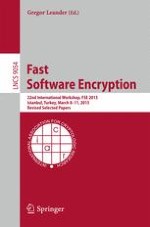This book constitutes the thoroughly refereed post-conference proceedings of the 22nd International Workshop on Fast Software Encryption, held in Istanbul, Turkey, March 8-11, 2015. The 28 revised full papers presented were carefully reviewed and selected from 71 initial submissions. The papers are organized in topical sections on block cipher cryptanalysis; understanding attacks; implementation issues; more block cipher cryptanalysis; cryptanalysis of authenticated encryption schemes; proofs; design; lightweight; cryptanalysis of hash functions and stream ciphers; and mass surveillance.
